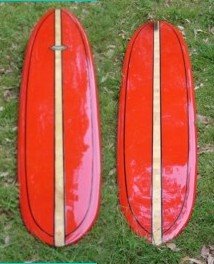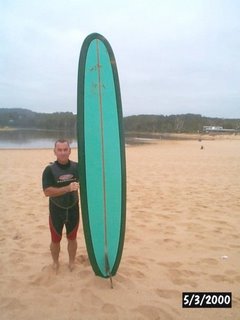 This is a BING. Built in California in 1961 by Bing Copeland.
This is a BING. Built in California in 1961 by Bing Copeland.This restoration can also be viewed with other restored Bings at the link below.
http://www.classicbingsurfboards.com/bingrestorations.html
 This is a BING. Built in California in 1961 by Bing Copeland.
This is a BING. Built in California in 1961 by Bing Copeland.

 The dings were reglassed and sanded. All the low spots and rails have been faired with a 75% Q-cell 25% aerosil mix. Two layers of 6oz laminated over. The stringer has been rebuilt. End grain balsa was used. Blocks were laminated together and milled into 10mm thick planks. These were glued together two at a time in the board to fit the rocker. Once the stringer was fully glued together and cured, it was removed, the edges cleaned up and glued into the board. Two layers of 8oz-boat cloth were laminated over the stringer with Vinylester resin.
The dings were reglassed and sanded. All the low spots and rails have been faired with a 75% Q-cell 25% aerosil mix. Two layers of 6oz laminated over. The stringer has been rebuilt. End grain balsa was used. Blocks were laminated together and milled into 10mm thick planks. These were glued together two at a time in the board to fit the rocker. Once the stringer was fully glued together and cured, it was removed, the edges cleaned up and glued into the board. Two layers of 8oz-boat cloth were laminated over the stringer with Vinylester resin.



The stringer and rails were masked and the pigment coats brushed on. I use a mixture of surfboard lam resin and neutral spray gelcoat. 75% resin 25% gelcoat and 3% Wax in Styrene. The gelcoat is designed to cling to vertical surfaces. This helps on the rails to minimise sagging and separation. The gelcoat ups the geltime slightly without having to use higher catalyst percentages. The board was sanded ready for glossing.
 The gloss coats were wet and dry sanded with 600, 1200 and 1500 and the machine polished.
The gloss coats were wet and dry sanded with 600, 1200 and 1500 and the machine polished. This is a KING steptail. Built by Graham King Surfboards on Sydneys South side in approx 1963. Graham King is still involved in the surboard industry today.
This is a KING steptail. Built by Graham King Surfboards on Sydneys South side in approx 1963. Graham King is still involved in the surboard industry today. As mentioned a new fin had to be made.
As mentioned a new fin had to be made. around 1964/65.
around 1964/65.